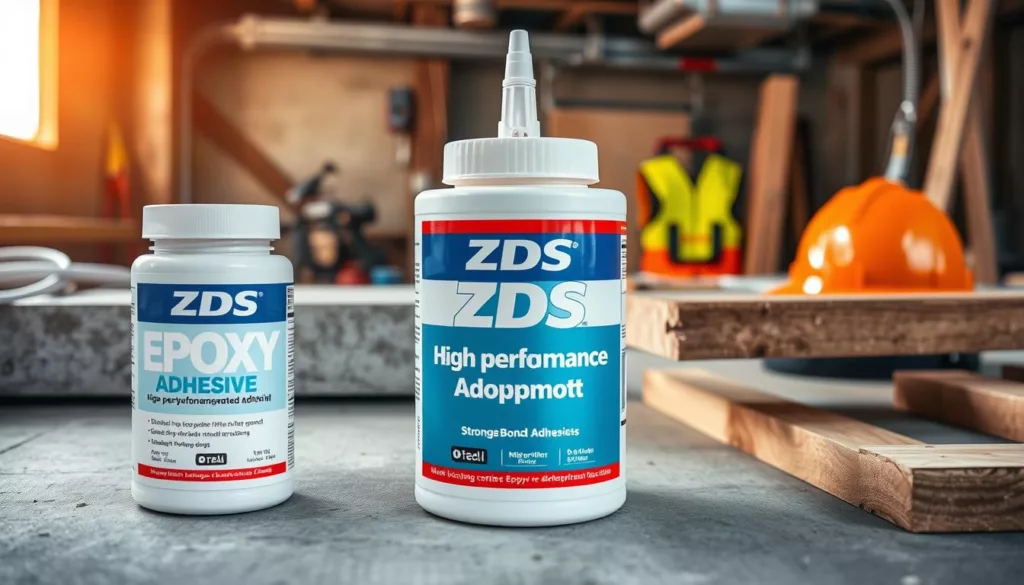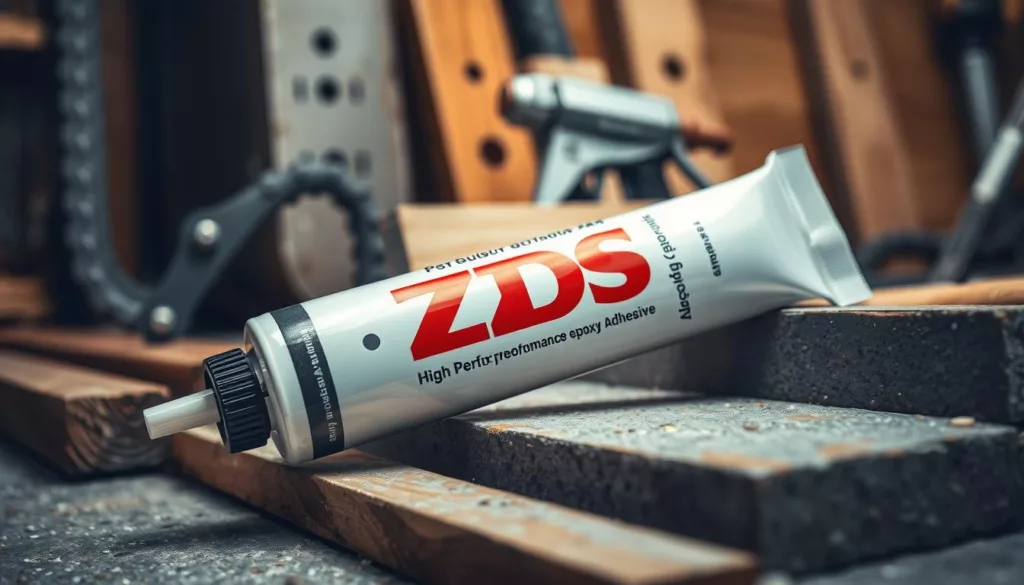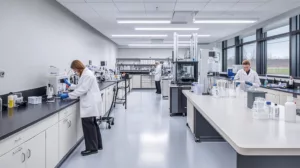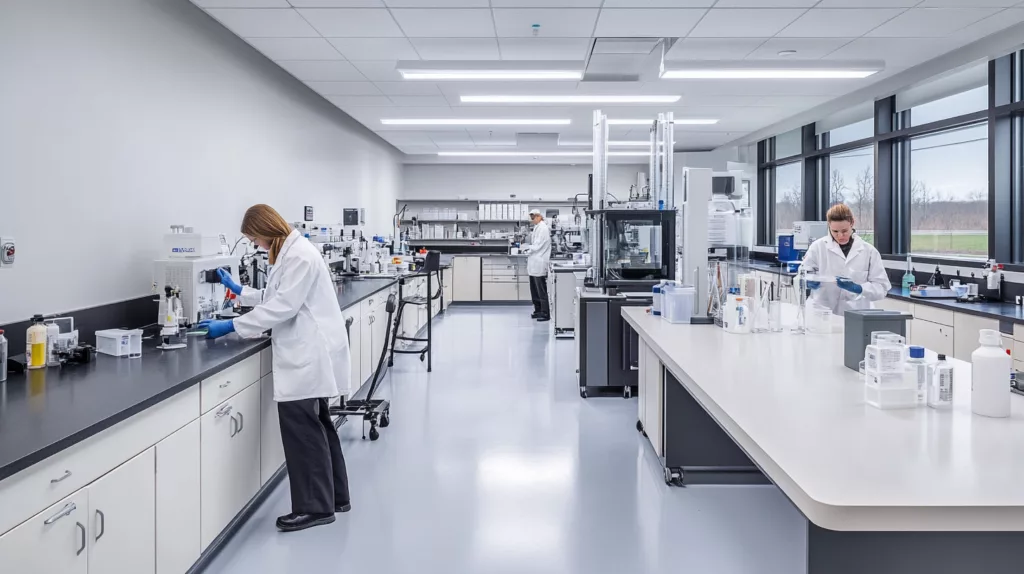In construction, the right adhesive is key to a project’s success. Our epoxy adhesive is made for tough jobs, ensuring strong and lasting bonds. This guide helps you pick and use epoxy adhesives for your projects. It’s vital to choose products that meet industry standards, helping both pros and DIYers get great results.
Key Takeaways
- High-performance epoxy adhesive provides reliable bonding strength for construction projects.
- Fast-curing epoxy adhesive allows for quicker project turnaround.
- Understanding epoxy adhesion properties ensures effective application.
- Choosing high-strength construction adhesive mitigates risks of bonding failures.
- Safety precautions must be adhered to during application and storage.
- Environmental considerations are increasingly important in adhesive development.
Understanding High-Performance Epoxy Adhesives
High-performance epoxy adhesives are key in construction projects. They mix resin and hardener to form a strong polymer. These adhesives are known for their strong bonding and flexibility.
Definition and Composition
High-performance epoxy adhesives are a two-part system. The resin bonds materials, and the hardener speeds up curing. This makes the adhesive strong and durable for many settings.
Key Properties and Benefits
Industrial adhesive has several important features:
- Exceptional Strength: Bonds well with different materials.
- Durability: Lasts long, even with wear and tear.
- Environmentally Resistant: Works well in various conditions, like moisture and heat.
- Customization: Can be made to fit specific project needs.
Typical Uses in Construction
High-performance epoxy adhesives are used in many ways in construction. They are used for:
- Bonding structural parts
- Sealing joints and cracks
- Fixing concrete and masonry
- Making composite materials
For more on how these adhesives work, check out this resource. It talks about picking the right adhesive for your project.

Advantages of Using Epoxy Adhesives
Epoxy adhesives have many benefits that make them great for construction projects. They are strong and versatile, making them perfect for many uses. Knowing these benefits helps manufacturers and DIY fans pick the best adhesive for their needs.
Strong Bonding for Diverse Materials
Epoxy adhesives bond well with many materials. This includes:
- Metals
- Wood
- Glass
- Concrete
- Plastic
They create strong bonds, even in tough conditions. This is very useful in construction, where different materials must work together.
Resistance to Environmental Factors
Epoxy adhesives can handle harsh conditions. They resist moisture, chemicals, and extreme temperatures. This makes them great for:
- Outdoor settings
- Wet areas like bathrooms and kitchens
- Industrial applications subject to chemical exposure
They are perfect for projects that need to last against weather and moisture.
Long-lasting Durability
Epoxy adhesives are known for their durability. Once dry, they form a strong bond that can withstand a lot of stress. This means constructions last longer, saving time and money in the long run.

| Advantage | Description | Application |
|---|---|---|
| Strong Bonding | Effectively bonds a variety of materials | Structural assemblies, repairs |
| Resistance to Environmental Factors | Withstands moisture, chemicals, and temperature changes | Outdoor, industrial settings |
| Long-lasting Durability | Provides a strong, enduring bond | Long-term constructions, heavy-duty applications |
Comparing Epoxy Adhesives to Other Adhesives
When looking at bonding options in construction, it’s key to know the differences between epoxy and other adhesives. This comparison shows the strengths and weaknesses of each type. It focuses on what matters most for heavy-duty projects. Epoxy adhesives stand out in many ways for these tough applications.
Epoxy vs. Polyurethane Adhesives
Polyurethane adhesives are flexible and versatile, good for some jobs. But for heavy-duty projects, epoxy adhesives are stronger. The main differences are:
- Adhesive Strength: Epoxy adhesives have higher tensile strength, making them ideal for demanding conditions.
- Curing Time: Polyurethane takes longer to cure than epoxy adhesives.
- Resistance to Chemicals: Epoxy adhesives resist harsh chemicals better, important in industrial settings.
Epoxy vs. Cyanoacrylate Adhesives
Cyanoacrylate adhesives, or super glue, are great for quick fixes and light-duty jobs. But they don’t last as long as epoxy adhesives. Key points to consider are:
- Bonding Capability: Epoxy is better for extensive and weight-bearing applications, making it top for heavy-duty projects.
- Heat Resistance: Epoxy adhesives handle higher temperatures than cyanoacrylate options.
- Moisture Resistance: Epoxy adhesives resist moisture better, lasting longer in various climates.
Performance in Extreme Conditions
In extreme temperatures, chemicals, or stresses, the adhesive’s integrity is critical. Epoxy adhesives perform well in such conditions:
- Temperature Limits: They withstand both high and low temperatures without degrading much.
- Longevity: Their durability makes them good for outdoor use in construction.
- Structural Integrity: The strength and reliability of industrial epoxy adhesives reduce the need for frequent maintenance and repairs.
For high-performance adhesive solutions, ZDS™ offers top-quality epoxy resins that meet industry standards. Choosing the right adhesive is key for the success of industrial and heavy-duty construction projects.

Selecting the Right Epoxy Adhesive
Choosing the right epoxy adhesive is key for great results in construction projects. There are many options, so it’s important to consider a few things. This ensures you pick the best one for your needs.
Factors to Consider in Your Project
When looking for a top-notch epoxy adhesive, remember these points:
- Material Compatibility: Make sure the adhesive works well with your materials.
- Curing Time: If you’re short on time, look for fast-curing options.
- Temperature Resistance: Check the adhesive’s temperature range.
- Viscosity: Thicker adhesives fill gaps, while thinner ones penetrate better.
- Aging and Environmental Resistance: See how the adhesive handles moisture, UV light, and chemicals.
Recommended Brands for Construction
Top brands offer reliable epoxy adhesives for different needs. Some top brands include:
- Loctite: Great for heavy-duty jobs.
- Gorilla Glue: Offers fast-curing options for both home and industrial use.
- West System: Best for marine-grade epoxy in outdoor projects.
- EpoxySet: Specializes in adhesives for high-stress areas.
Technical Specifications to Review
Look at these technical specs to make a smart choice:
| Specification | Importance | Recommended Value |
|---|---|---|
| Cure Time | Speed of bonding | 30 minutes to 24 hours depending on application |
| Bond Strength | Durability of the joint | Up to 3000 psi |
| Viscosity | Ease of application | 1,000 to 10,000 cP |
| Working Temperature Range | Performance in various environments | -40°F to 200°F |

Application Techniques for Epoxy Adhesives
Using epoxy adhesive in building projects needs special techniques. These ensure the adhesive works well and holds strong. Knowing how to prepare, mix, and apply the adhesive is key.
Surface Preparation Tips
Getting the surfaces ready is very important. Make sure they are clean and dry for the best results. Here are some steps to follow:
- Remove dirt, grease, and debris using solvents or abrasives.
- Sand rough surfaces to create a better bond.
- Ensure surfaces are dry and free of moisture.
Mixing and Curing Processes
Mixing the epoxy correctly is vital for strong bonds. Here’s what to do:
- Measure the resin and hardener accurately based on the manufacturer’s instructions.
- Stir the mixture slowly but thoroughly to avoid introducing air bubbles.
- Apply the mixed epoxy adhesive promptly to prevent premature curing.
Common Application Methods
There are many ways to apply high-strength construction adhesive. The right method depends on the project:
| Method | Description | Best For |
|---|---|---|
| Brush Application | Using a brush to spread adhesive evenly across surfaces. | Large or flat surfaces. |
| Roller Application | Rolling the adhesive on to cover larger areas efficiently. | Extensive bonding surfaces. |
| Caulking Gun | Dispensing adhesive directly from a cartridge for precise application. | Sealing and bonding in tight spots. |
For special tasks, look into specialized adhesives. ZDS™ has advanced adhesives for building needs. They ensure strong bonds and efficient use. Check out their range to find the right one for your.

Safety Precautions with Epoxy Adhesives
Working with high-performance epoxy adhesives for construction projects requires safety first. It’s important to know about protective gear, ventilation, and how to handle and store these chemicals. This can help lower health risks.
Protective Gear and Equipment
When working with epoxy adhesives, wearing the right protective gear is key. You should have:
- Safety goggles to protect your eyes from splashes
- Nitrile gloves to keep your skin from coming into contact with the adhesive
- Respirators to filter out harmful vapors when applying the adhesive
- Long-sleeved clothing to cover your skin and prevent exposure
Proper Ventilation Practices
Good ventilation is essential when using epoxy adhesives. It helps prevent inhaling harmful fumes. Here are some ways to ensure proper ventilation:
- Work in areas with good airflow, like outdoors
- Use fans or exhaust systems to improve air movement
- Open windows and doors to let in fresh air
Handling and Storage Guidelines
Safe handling and storage of epoxy adhesives are critical for long-term safety. Follow these guidelines:
- Store adhesives in cool, dry places away from sunlight.
- Keep containers sealed when not in use to avoid spills.
- Always read and follow the manufacturer’s instructions for safe use and disposal.
Troubleshooting Common Issues
Dealing with common problems with epoxy adhesives is key to a successful project. Knowing about bonding failures, curing issues, and how to fix them can make your adhesive work better. Here, we’ll talk about common issues and how to solve them.
Bonding Failures: Causes and Solutions
Bonding failures can happen for a few reasons:
- Surface contamination: Dust, oil, or moisture can ruin the bond.
- Incorrect mixing ratios: It’s important to mix it right for the best results.
- Inadequate surface preparation: A clean and smooth surface is needed for a strong bond.
To fix these problems, make sure surfaces are clean and dry. Follow the mixing instructions carefully. Also, prepare the surfaces well before applying the adhesive.
Curing Issues: Identifying Problems
Problems with curing can show up as weak or incomplete bonds. Look out for:
- Visual inspection: Check for bubbles or soft spots on the bond line.
- Poor environmental conditions: Extreme temperatures and humidity can mess with curing.
It’s important to keep an eye on temperature and humidity while the adhesive is curing. Adjust these conditions if needed to help the adhesive cure properly.
Tips for Effective Repairs
When you face bonding failures or curing issues, quick and effective repairs are essential:
- Find and fix the root cause of the problem.
- Apply the epoxy again after cleaning and preparing the surface well.
- Use the same epoxy for repairs to ensure it works well together.
Environmental Considerations
As we face more environmental issues, the need for green building materials grows. This includes adhesives. Choosing eco-friendly epoxy options can lessen our environmental footprint while keeping quality high. Knowing how these adhesives affect air quality and how to dispose of them helps make our spaces healthier.
Eco-Friendly Epoxy Options
Today, many brands offer eco-friendly epoxy options with low VOCs. These products emit fewer harmful fumes, making them safe for indoor use. Using these options supports the environment and improves our health at work. Some notable examples include:
- Bio-Based Epoxy Resins: Made from renewable sources, these resins are better for the planet.
- Low VOC Formulations: These epoxies keep the air clean, ensuring safety for users.
- Recyclable Packaging: Brands that care about the planet often use packaging that can be recycled, reducing waste.
Impact of Epoxy on Indoor Air Quality
The type of epoxy used can greatly affect the air inside. Traditional epoxies can release VOCs, which can harm air quality and health. Choosing eco-friendly options can help keep our spaces healthier.
Waste Management and Disposal Practices
It’s important to handle epoxy waste properly. Unused or mixed epoxy must be disposed of safely to avoid harming the environment. Here are some steps to follow:
- Check local laws for disposing of hazardous waste.
- Look for recycling programs that accept epoxy products.
- Consider donating or giving away extra materials to local projects.
| Eco-Friendly Feature | Benefits |
|---|---|
| Low VOC | Improves indoor air quality |
| Bio-Based Ingredients | Reduces reliance on fossil fuels |
| Recyclable Packaging | Minimizes waste in landfills |
By understanding these points, both manufacturers and DIY fans can make choices that are better for the planet. They can do this without losing quality or performance in their projects.
Future Trends in Epoxy Adhesive Technology
Epoxy adhesives are on the verge of big changes, promising better performance in construction. New innovations will make them work better in different conditions. They will handle extreme temperatures and humidity, making them useful for more projects.
Innovations in Formulation and Performance
Scientists are working on new epoxy adhesives. They aim to create ones that bond stronger and are easier to use. This means adhesives that mix and dry faster, helping projects finish quicker.
Sustainability Trends in Adhesive Production
The construction world is moving towards greener options, including adhesives. We’ll see more bio-based and eco-friendly materials. This shift will help the planet and meet new rules and customer wants.
Predictions for the Construction Industry
The construction field will change a lot thanks to new adhesives. These adhesives will make buildings and repairs better. To keep up, professionals need to learn about these new products. For tips on using adhesives well, check out this resource.
FAQ
What makes high-performance epoxy adhesives suitable for construction projects?
High-performance epoxy adhesives are made to be strong and last long. They bond well with materials like concrete, metal, and wood. This makes them perfect for tough construction jobs.
How do I select the right epoxy adhesive for my construction needs?
When picking an epoxy adhesive, think about the materials you’re bonding, the environment, and how long it needs to cure. Also, check the technical specs to make sure it fits your project.
Are epoxy adhesives waterproof?
Yes, many epoxy adhesives are waterproof. This is great for jobs in wet or humid places.
How long does it take for a fast-curing epoxy adhesive to set?
Fast-curing epoxy adhesives set quickly, often in minutes. But, they need several hours to fully cure. Always check the manufacturer’s instructions for the best results.
What safety precautions should I take when using epoxy adhesives?
Wear gloves and goggles when working with epoxy adhesives. Make sure your workspace is well-ventilated to avoid breathing in fumes. Follow the guidelines for handling and storing to stay safe.
Can I use epoxy adhesive for outdoor projects?
Yes! Industrial epoxy adhesives are great for outdoor projects. They resist moisture and temperature changes, making them reliable in different conditions.
How do epoxy adhesives compare to polyurethane adhesives?
Epoxy adhesives are stronger and more durable than polyurethane adhesives. They’re perfect for heavy-duty projects. Polyurethane is more flexible but can’t handle heavy loads as well.
What are some common issues that can arise when using epoxy adhesives?
Common problems include bonding failures from bad surface prep or mixing mistakes. Curing issues can also happen if the environment is wrong. Fixing these problems can help your projects succeed.
Are there eco-friendly options available for epoxy adhesives?
Yes, there are eco-friendly epoxy options. They’re strong but also good for the environment. Look for products that are labeled as eco-friendly if you care about sustainability.











